Microbiology of Food Products
The assignment requires the candidate to describe the practical methodology for establishing a microbiological profile of a named food sample, including the techniques used and their rationale.
21 Pages4661 Words253 Views
Added on 2023-06-10
About This Document
This article covers practical methodologies for microbial examination of foods, culture techniques, Macconkey agar, salmonella infection, gram staining method for yogurt and more. It also provides information on the significance of salmonella infection and its effects on human health. Subject: Food Microbiology, Course Code: NA, Course Name: NA, College/University: NA.
Microbiology of Food Products
The assignment requires the candidate to describe the practical methodology for establishing a microbiological profile of a named food sample, including the techniques used and their rationale.
Added on 2023-06-10
ShareRelated Documents
Running Head: MICROBIOLOGY OF FOOD PRODUCTS
0
Food Microbiology
Student details
0
Food Microbiology
Student details
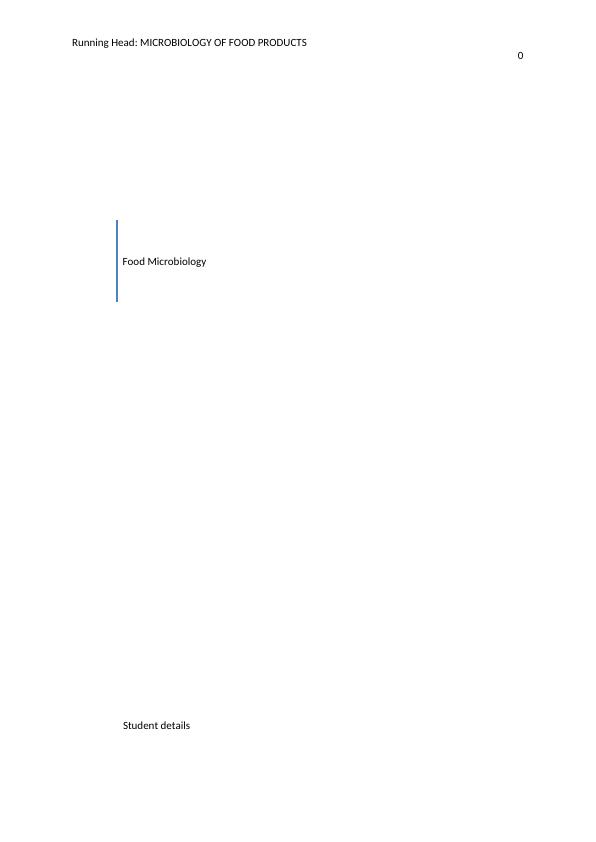
MICROBIOLOGY OF FOOD PRODUCTS 1
Table of Contents
Answer one: Practical methodology......................................................................................................1
Steps involved in culture media technique.........................................................................................1
Answer second......................................................................................................................................3
1. Macconkey agar.........................................................................................................................3
2. The appearance of coliform.......................................................................................................5
3. Difference between types of Media...............................................................................................5
Answer three.........................................................................................................................................6
The significance of statement............................................................................................................6
Effects of salmonella on human health..............................................................................................7
Answer four...........................................................................................................................................8
A) Gram staining method for yogurt...........................................................................................8
B) Gram staining involves three simple processes....................................................................10
Answer five..........................................................................................................................................11
Notifiable disease............................................................................................................................11
Report the notifiable disease...........................................................................................................12
Answer six...........................................................................................................................................13
Campylobacter.................................................................................................................................13
References...........................................................................................................................................16
Table of Contents
Answer one: Practical methodology......................................................................................................1
Steps involved in culture media technique.........................................................................................1
Answer second......................................................................................................................................3
1. Macconkey agar.........................................................................................................................3
2. The appearance of coliform.......................................................................................................5
3. Difference between types of Media...............................................................................................5
Answer three.........................................................................................................................................6
The significance of statement............................................................................................................6
Effects of salmonella on human health..............................................................................................7
Answer four...........................................................................................................................................8
A) Gram staining method for yogurt...........................................................................................8
B) Gram staining involves three simple processes....................................................................10
Answer five..........................................................................................................................................11
Notifiable disease............................................................................................................................11
Report the notifiable disease...........................................................................................................12
Answer six...........................................................................................................................................13
Campylobacter.................................................................................................................................13
References...........................................................................................................................................16
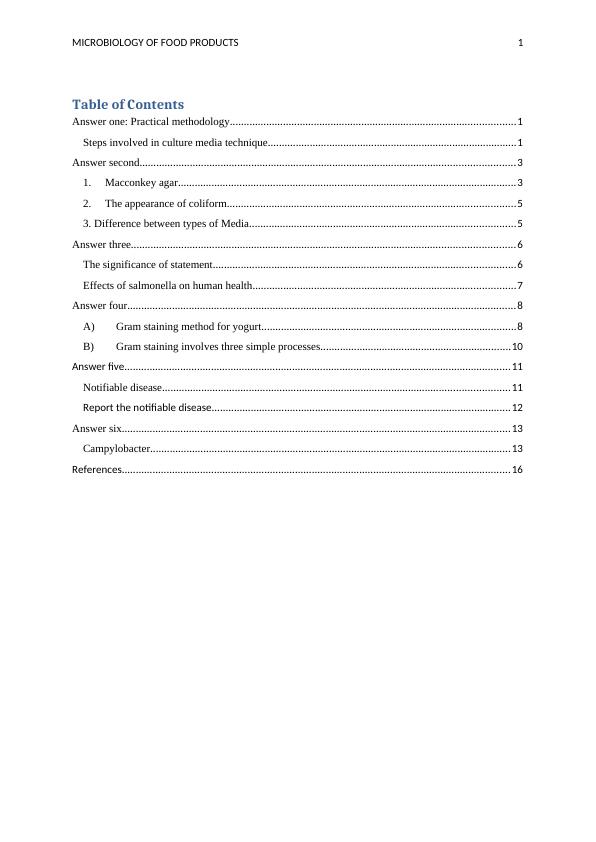
MICROBIOLOGY OF FOOD PRODUCTS 2
Answer one: Practical methodology
There are various practical methodologies can be used for microbial examination or analysis
of foods for example indicator organism’s method, direct examination, culture techniques,
enumeration method, laboratory accreditation, and rapid methods to detect specific micro-
organism and toxin. The culture techniques provide the opportunity to grow microbial sample
in a liquid or on a solid surface. Agar is the polysaccharide with various beneficial properties
produced by a species of red algae. Different properties of agar include the ability to form the
gel at the concentration or 1 to 2 percent. Such gel is able to stabilize on the high-temperature
process in boiling water bath to melt. It stability to the microbial hydrolysis is another
property of agar.
Various types of agar can be used for culture techniques such as plate count agar,
MacConkey Broth, lactose broth, glucose agar, blood agar and sucrose agar (Parija, 2014).
The main purpose of the media such as nutrient agar, plate count agar, malt extract agar and
the dextrose agar for fungi is to provide the nutrition for the growth of microorganisms (Liu,
2018). Culture media techniques provide both qualitative and the quantitative results of
microorganisms. This information not only provides data about the presence and absence of
microorganism but also provide the information of the number of the organisms.
Steps involved in culture media technique
For Yoghurt
Sample collection
The food sample containing salmonella should be mixed to make sure the homogeneity
before taking the specific amount. The food sample should be pre-enriched at a sample to
Answer one: Practical methodology
There are various practical methodologies can be used for microbial examination or analysis
of foods for example indicator organism’s method, direct examination, culture techniques,
enumeration method, laboratory accreditation, and rapid methods to detect specific micro-
organism and toxin. The culture techniques provide the opportunity to grow microbial sample
in a liquid or on a solid surface. Agar is the polysaccharide with various beneficial properties
produced by a species of red algae. Different properties of agar include the ability to form the
gel at the concentration or 1 to 2 percent. Such gel is able to stabilize on the high-temperature
process in boiling water bath to melt. It stability to the microbial hydrolysis is another
property of agar.
Various types of agar can be used for culture techniques such as plate count agar,
MacConkey Broth, lactose broth, glucose agar, blood agar and sucrose agar (Parija, 2014).
The main purpose of the media such as nutrient agar, plate count agar, malt extract agar and
the dextrose agar for fungi is to provide the nutrition for the growth of microorganisms (Liu,
2018). Culture media techniques provide both qualitative and the quantitative results of
microorganisms. This information not only provides data about the presence and absence of
microorganism but also provide the information of the number of the organisms.
Steps involved in culture media technique
For Yoghurt
Sample collection
The food sample containing salmonella should be mixed to make sure the homogeneity
before taking the specific amount. The food sample should be pre-enriched at a sample to
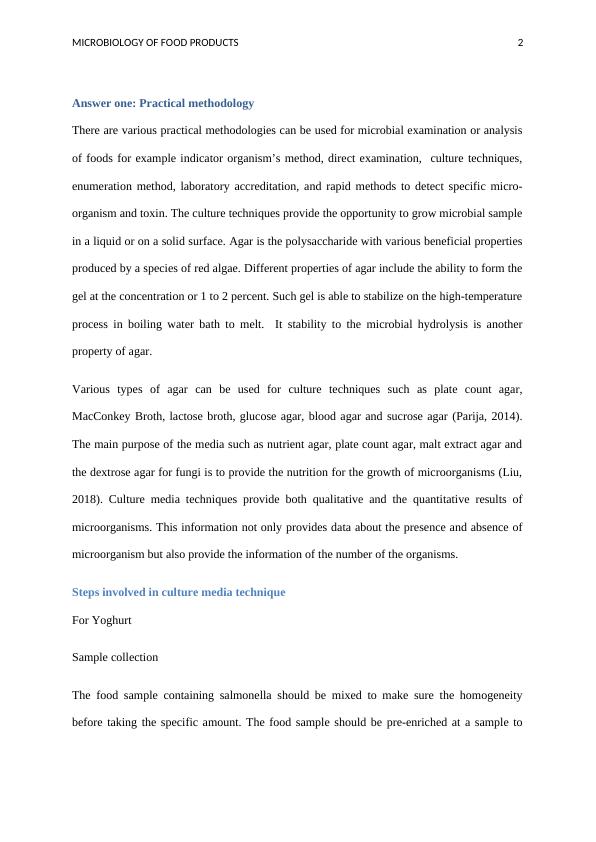
MICROBIOLOGY OF FOOD PRODUCTS 3
broth ratio of 1:9 dilutions. The sample should be kept favorable environment. The sample
collected for analysis can be the raw or finished product (Andrew and Hammack, 2018).
Dilution
If the count is expected to be higher than 2.5* 103 per ml, than the decimal dilution should be
prepared as:
Shaking the dilution and fresh sterile pipette should be used for each dilution. Pipette one ml
of homogenate into a glass tube containing 9 ml of the diluent. One ml is transferred from the
first dilution to the second dilution tube, which contains 9 ml of the diluent. This will be
repeated to third, fourth, fifth and more glass tubes until the expected dilution is obtained.
Pour plating
All the Petri plates should be labeled with sample number, date, dilution and other necessary
information. One ml of food homogenate pipetted into a petri dish in duplicate. Ten to twelve
ml of agar poured into each Petri plate. The media and the dilution should be mixed gently by
swirling, clockwise and anticlockwise. The prepared media with dilution is then allowed to
set.
Incubation
The prepared dishes are then incubated in an incubator, inverted at 35 degrees or at the
desired temperature.
Count colonies
After incubation, bacterial colonies grown on culture median Petri dishes can be counted
which are between 30 to 300.
Calculation
broth ratio of 1:9 dilutions. The sample should be kept favorable environment. The sample
collected for analysis can be the raw or finished product (Andrew and Hammack, 2018).
Dilution
If the count is expected to be higher than 2.5* 103 per ml, than the decimal dilution should be
prepared as:
Shaking the dilution and fresh sterile pipette should be used for each dilution. Pipette one ml
of homogenate into a glass tube containing 9 ml of the diluent. One ml is transferred from the
first dilution to the second dilution tube, which contains 9 ml of the diluent. This will be
repeated to third, fourth, fifth and more glass tubes until the expected dilution is obtained.
Pour plating
All the Petri plates should be labeled with sample number, date, dilution and other necessary
information. One ml of food homogenate pipetted into a petri dish in duplicate. Ten to twelve
ml of agar poured into each Petri plate. The media and the dilution should be mixed gently by
swirling, clockwise and anticlockwise. The prepared media with dilution is then allowed to
set.
Incubation
The prepared dishes are then incubated in an incubator, inverted at 35 degrees or at the
desired temperature.
Count colonies
After incubation, bacterial colonies grown on culture median Petri dishes can be counted
which are between 30 to 300.
Calculation
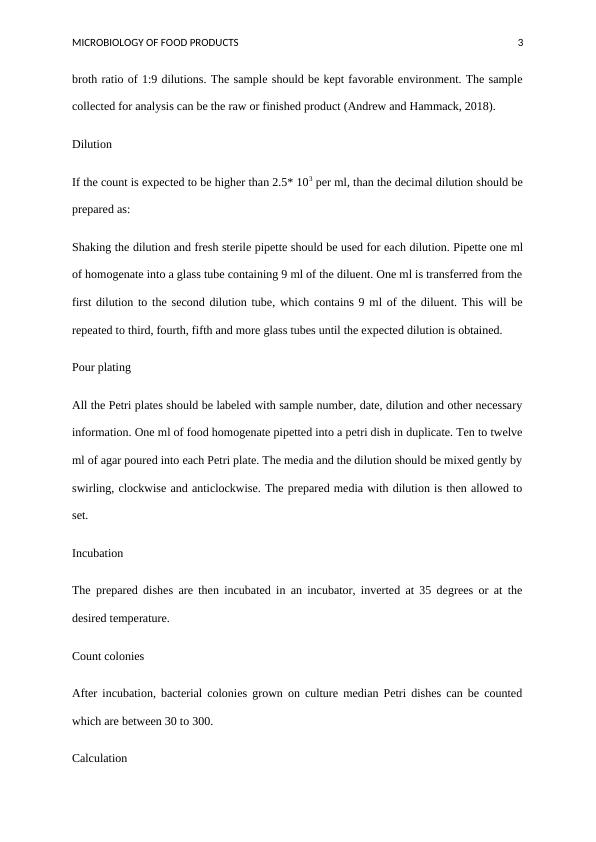
MICROBIOLOGY OF FOOD PRODUCTS 4
In the dishes containing 30 to 300 colonies, the real number in both Petri plates of dilution is
then counted with the help of mathematical formula:
N= ∑ C
( N 1+0.1 N 2 ) D
Where;
∑ C: is the total number of microbial colonies counted on the Petri plates
N1: is the number of Petri plates retained in the 1st dilution
N2: is determined as the number of petridishes retained in 2nd dilution
D: is the dilution factor (FSSAI, 2012).
Answer second
1. Macconkey agar
It was first developed by Alfred Theodore MacConkey in the 20th century and was the 1st
solid differential media. MCA or is a differential and selective media which is used to
isolate and differentiate the no-fastidious gram-negative bacteria, which belongs to the
family of Enterobacteriaceae and genus Pseudomonas.
Uses of MacConkey Agar
The MacConkey agar is used to isolate the bacteria (gram-negative).
This type of agar can also be used to separate the lactose fermenting bacteria from the
lactose non-fermenting gram-negative microorganism.
It is also used to isolate coliforms and the intestinal disease-causing microorganism in
water, biological specimens and dairy product (Engelkirk and Engelkirk, 2008).
In the dishes containing 30 to 300 colonies, the real number in both Petri plates of dilution is
then counted with the help of mathematical formula:
N= ∑ C
( N 1+0.1 N 2 ) D
Where;
∑ C: is the total number of microbial colonies counted on the Petri plates
N1: is the number of Petri plates retained in the 1st dilution
N2: is determined as the number of petridishes retained in 2nd dilution
D: is the dilution factor (FSSAI, 2012).
Answer second
1. Macconkey agar
It was first developed by Alfred Theodore MacConkey in the 20th century and was the 1st
solid differential media. MCA or is a differential and selective media which is used to
isolate and differentiate the no-fastidious gram-negative bacteria, which belongs to the
family of Enterobacteriaceae and genus Pseudomonas.
Uses of MacConkey Agar
The MacConkey agar is used to isolate the bacteria (gram-negative).
This type of agar can also be used to separate the lactose fermenting bacteria from the
lactose non-fermenting gram-negative microorganism.
It is also used to isolate coliforms and the intestinal disease-causing microorganism in
water, biological specimens and dairy product (Engelkirk and Engelkirk, 2008).

MICROBIOLOGY OF FOOD PRODUCTS 5
Components of MacConkey Agar
Peptone
Lactose
Bile salts
NaCl
Neutral red
Agar
pH 7.4 ± 0.2 (Atlas, 2010).
Peptone
Peptones are the excellent sources of amino acids, proteins, and peptides in growth media.
This mixture of amino acids and protein can be obtained from natural products such as milk,
plants and animal tissue. Peptones provide the important nutrients, nitrogenous factors, and
vitamins that are required for the growth of the microorganism.
Lactose
Lactose is the disaccharides or sugar composed of galactose and glucose. The scientific
formula for lactose is C12H22011. In MacConkey agar, lactose monohydrate is a fermentable
source of carbohydrates. It helps to distinguish between the lactose fermenters and non-
fermenters. This feature of lactose helps the medium to be selective for lactose fermenters.
Bile Salts
Bile salts are the primary component of bile. In MacConkey Agar, It helps the agar media to
be highly selective for gram-negative bacteria and prevent the growth of gram-positive
microorganism.
Components of MacConkey Agar
Peptone
Lactose
Bile salts
NaCl
Neutral red
Agar
pH 7.4 ± 0.2 (Atlas, 2010).
Peptone
Peptones are the excellent sources of amino acids, proteins, and peptides in growth media.
This mixture of amino acids and protein can be obtained from natural products such as milk,
plants and animal tissue. Peptones provide the important nutrients, nitrogenous factors, and
vitamins that are required for the growth of the microorganism.
Lactose
Lactose is the disaccharides or sugar composed of galactose and glucose. The scientific
formula for lactose is C12H22011. In MacConkey agar, lactose monohydrate is a fermentable
source of carbohydrates. It helps to distinguish between the lactose fermenters and non-
fermenters. This feature of lactose helps the medium to be selective for lactose fermenters.
Bile Salts
Bile salts are the primary component of bile. In MacConkey Agar, It helps the agar media to
be highly selective for gram-negative bacteria and prevent the growth of gram-positive
microorganism.
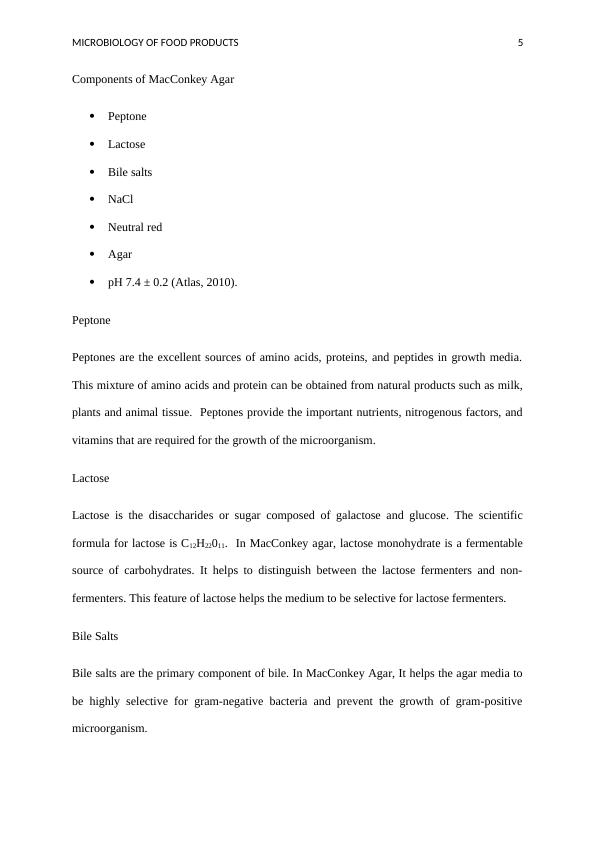
End of preview
Want to access all the pages? Upload your documents or become a member.
Related Documents
Presence of Pathogenic Bacteria in Raw Meat Dog Foodlg...
|5
|1337
|56
Food Microbiology - Sample Assignmentlg...
|29
|5686
|364
PY162 Therapeutics : Assignmentlg...
|12
|2057
|120
Methods for Microorganism Enumeration and Factors Affecting Growthlg...
|4
|1279
|72
Microbiology Assignment: Microbial Analysis of Raw Fishlg...
|22
|4653
|250
